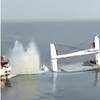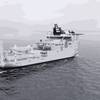The National Transportation Safety Board
today released its final report on its investigation into
the collision between a U.S. Navy submarine, the USS
Greeneville, and a Japanese motor vessel, the Ehime Maru.
The collision resulted in the sinking of the Japanese vessel
and the deaths of 9 of her crew.
The accident occurred February 9, 2001, off the coast of
Hawaii, when the submarine struck the motor vessel while
performing an emergency surfacing maneuver during a
demonstration cruise as part of the Navy's Distinguished
Visitors Program. The Japanese fishing and training vessel
was in the middle of a 74-day training voyage.
The Safety Board determined the probable cause of the
accident to be the inadequate interaction and communication
among senior members of the combat systems team on the
submarine, which resulted in the failure to perform adequate
contact analysis, to adhere to proper procedures for moving
to periscope depth; and the commanding officer's decision to
order an emergency surfacing maneuver. Contributing to the
cause of the accident, the Board found, was the failure of
the crew, in particular the commanding officer, to
adequately manage the civilian visitors so that they did not
impede operations. Contributing to the loss of life was the
rapid flooding and sinking of the Ehime Maru, which occurred
when the submarine's rudder tore through the fishing
vessel's lower deck spaces.
The NTSB's report is available on its website at
www.ntsb.gov, under "Publications", "Marine." It describes
the Board's factual findings and analysis, as well as
corrective actions taken by the Navy since the accident.
Sponsored Content
Safer Starts Here: Build Ships, Protect Crews

Subscribe for
Maritime Reporter E-News
Maritime Reporter E-News is the maritime industry's largest circulation and most authoritative ENews Service, delivered to your Email five times per week











